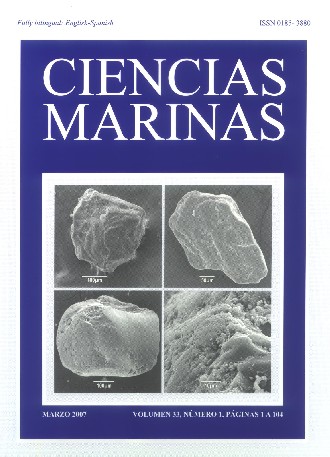Accumulation of Corg, Norg, Porg and BSi off the Magdalena, BCS, (México) during the past 26 kyr
Main Article Content
Abstract
The rates of accumulation of organic carbon, nitrogen and phosphorus (Corg, Norg, Porg), and of biogenic silica (BSi) were measured in sediment cores (GC31 and PC08) collected within the oxygen minimum zone of the Magdalena margin, off western Baja California Sur (Mexico). The rates of Corg, Norg and Porg accumulation were similar during marine isotopic stage 2 (MIS-2), the last glacial maximum (LGM) and the Late Holocene (LH, 3 kyr–Recent), whereas the rate of BSi accumulation was greater during LGM and MIS-2 than during LH. In general, primary productivity during the MIS-2 and the LGM was similar to that observed during LH. The N/P ratio during the MIS-2 and the LGM was equivalent to that found during LH, suggesting that N and P were not limiting factors. In fact, the BSi/C ratio was relatively high (intense upwelling) when the N/P ratio was relatively low, indicating similar levels of primary productivity during the MIS-2, the LGM and LH. The results show that the productivity levels during LH are characteristic, at least, of those that existed during the MIS-2. This indicates that the wind system has persisted since then, favouring an Ekman transport along the coast of California and Baja California, generating diatomdominated primary productivity.
Downloads
Article Details
This is an open access article distributed under a Creative Commons Attribution 4.0 License, which allows you to share and adapt the work, as long as you give appropriate credit to the original author(s) and the source, provide a link to the Creative Commons license, and indicate if changes were made. Figures, tables and other elements in the article are included in the article’s CC BY 4.0 license, unless otherwise indicated. The journal title is protected by copyrights and not subject to this license. Full license deed can be viewed here.

